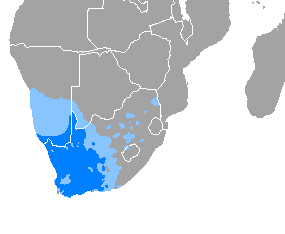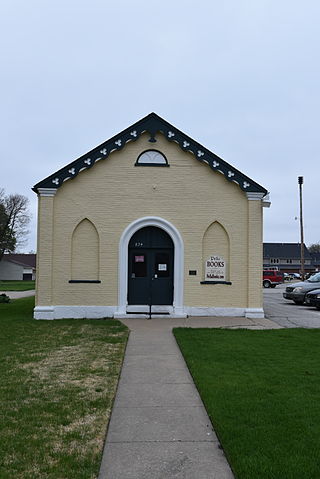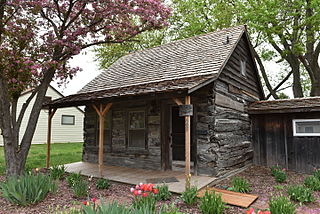
Afrikaans is a West Germanic language, spoken in South Africa, Namibia and Botswana, Zambia and Zimbabwe. It evolved from the Dutch vernacular of South Holland spoken by the predominantly Dutch settlers and enslaved population of the Dutch Cape Colony, where it gradually began to develop distinguishing characteristics in the course of the seventeenth and eighteenth centuries.

Pella is a city in Marion County, Iowa, United States, with a population of 10,464 at the time of the 2020 U.S. Census. Founded by immigrants from the Netherlands, it is forty miles southeast of Des Moines. Pella is the home of Central College, as well as several manufacturing companies, including Pella Corporation and Vermeer Manufacturing Company.

Ancient Greek includes the forms of the Greek language used in ancient Greece and the ancient world from around 1500 BC to 300 BC. It is often roughly divided into the following periods: Mycenaean Greek, Dark Ages, the Archaic or Epic period, and the Classical period.

Javanese is a Malayo-Polynesian language spoken by the Javanese people from the central and eastern parts of the island of Java, Indonesia. There are also pockets of Javanese speakers on the northern coast of western Java. It is the native language of more than 68 million people.

Limburgish, also called Limburgan, Limburgian, or Limburgic, is a West Germanic language spoken in Dutch Limburg, Belgian Limburg, and neighbouring regions of Germany.

Central College is a private college located in Pella, Iowa, and affiliated with the Reformed Church in America. The college was founded in 1853 and has been accredited by the Higher Learning Commission since 1942. Central has a student body of approximately 1,100 undergraduates and 73 academic programs.

Frankish, also known as Old Franconian or Old Frankish, was the West Germanic language spoken by the Franks from the 5th to 9th century.
The Pella curse tablet is a text written in a distinct Doric Greek idiom, found in Pella, the ancient capital of Macedon, in 1986. Ιt contains a curse or magic spell inscribed on a lead scroll, dated to the first half of the 4th century BC. It was published in the Hellenic Dialectology Journal in 1993. The Pella curse tablet exhibits some of the typical Northwest Greek features, as well as a cluster of unique Doric features that do not appear in other subdialects of this family. It represents the same or a very similar vernacular dialect that is also attested in the other Doric inscriptions from Macedonia. This indicates that a Doric Greek dialect was not imported, but proper to Macedon. As a result, the Pella curse tablet has been forwarded as an argument that the Ancient Macedonian language was a dialect of Northwest Greek, and one of the Doric dialects.
Amana German is a regiolect based on West Central German that is still spoken by several hundred people in the Amana Colonies in Iowa.

Pella is an ancient city located in Central Macedonia, Greece. It served as the capital of the ancient Greek kingdom of Macedon.

Cyrenus Cole was a newspaper editor, columnist and historian, then a Republican U.S. Representative from Iowa's 5th congressional district for over eleven years.
Dutch dialects are primarily the dialects that are both cognate with the Dutch language and spoken in the same language area as the Dutch standard language. They are remarkably diverse and are found within Europe mainly in the Netherlands and northern Belgium.

Dutch is a West Germanic language, spoken by about 25 million people as a first language and 5 million as a second language and is the third most spoken Germanic language. In Europe, Dutch is the native language of most of the population of the Netherlands and Flanders. In South America, it is the native language of the majority of the population of Suriname, and spoken as a second language in the polyglot Caribbean island countries of Aruba, Curaçao and Sint Maarten. All these countries have recognised Dutch as one of their official languages, and are involved in one way or another in the Dutch Language Union. Dutch Caribbean municipalities have Dutch as one of the official languages too. Up to half a million native speakers reside in the United States, Canada and Australia combined, and historical linguistic minorities on the verge of extinction remain in parts of France and Germany.
Yuyu (Yirau) is an extinct language or dialect cluster of southern South Australia. Walsh treats Yuyu as a language with Ngawait, Erawirung, Ngintait, and Ngarkat as dialects; Berndt and Berndt (1993) list those as dialects related to Yuyu.

First Christian Church is a historic church at 824 Franklin Street in Pella, Iowa.

The Dutch letter is a type of pastry that is typically prepared using a mixture of flour, eggs and butter or puff pastry as its base and filled with almond paste, dusted with sugar and shaped in an "S" or other letter shape. Marzipan, an almond paste prepared with almond meal and honey or sugar, is sometimes used as the filling. The Dutch letter has a porous or airy and flaky texture.

The Thomas F. and Nancy Tuttle House, also known as the Tuttle Cabin, is a historic residence located in Pella, Iowa, United States. Built in 1843, it predates the founding of the Pella, and is therefore the oldest building in town. The 1½-story log cabin contains a single room, and was built as a farmhouse for a homestead claim by Thomas Tuttle. In 1847 Pella's founder, Dominie Henry P. Scholte, bought the dwelling and farm from Tuttle for the location of the settlement for Dutch immigrants. Scholte sold the cabin in 1866. The last family to live here was the Sneller family who lived here from 1912 to 1973. Robert Van Vark bought the cabin at an auction in 1973 and his daughter, Gail Van Vark Kirby, inherited it from him. The house was listed on the National Register of Historic Places in 2015. The Historic Pella Trust acquired the property in April of the same year.

The William Van Asch House-Huibert Debooy Commercial Room, also known as the Central College Temporary Quarters, is a historic building located in Pella, Iowa, United States. It is one of the finest extant examples of vernacular architecture that the early Dutch settlers to Pella brought with them from the Netherlands. Both Van Asch and Debooy were among the earliest settlers in Pella. Van Asch had the two-story brick house built in 1854. Before he and his wife could move in, he rented the house to Central University of Iowa for its use. The college used it for two years. DeBooy built the 1½-story brick commercial room to the east in 1856. He bought the Van Asch's house in 1864 and joined the two buildings together with a hyphen. The DeBooys lived in the house. After they died in the early 20th century the entire complex housed apartments. The Strawtown Corporation bought it in 1974 and it now houses retail businesses.
The Gary J. and Matilda Vermeer Farmstead is a historic building located east of Pella, Iowa, United States, in Mahaska County. Gerrit "Gary" Vermeer was born on a farm outside of Pella on September 29, 1918, and was educated in the local schools. He married Matilda Van Gorp at her parents’ farm on February 14, 1941. They farmed a 120-acre (49 ha) farm that had been given to them by his parents. They built this modest house on that farm in 1953 and lived here the rest of their married life. Gary invented a wagon hoist that made it easier to unload corn. It became so popular that he and his cousin, Ralph Vermeer, started the Vermeer Company to manufacture the device as well as other agricultural implements. In 1971 Gary developed the Vermeer round hay baler, "an invention that revolutionized agriculture." In addition to his business and farming, Gary was involved in the Pella community and The Christian Reformed Church in North America. He died in Pella on February 2, 2009. Matilda, who was born near Pella on February 14, 1920, died on July 19, 2014. They are buried in Oakwood Cemetery, Pella. The farmstead was listed on the National Register of Historic Places in 2018.
Richland Township is a township located in the northwest corner of Mahaska County, Iowa, United States bordering Jasper County to its north and Marion County to its west. Peoria, founded 1853, is the last remaining village (unincorporated) in the township, but the communities of Warrensville, Lower Grove, and Granville once existed as unincorporated populated places in Richland township.














